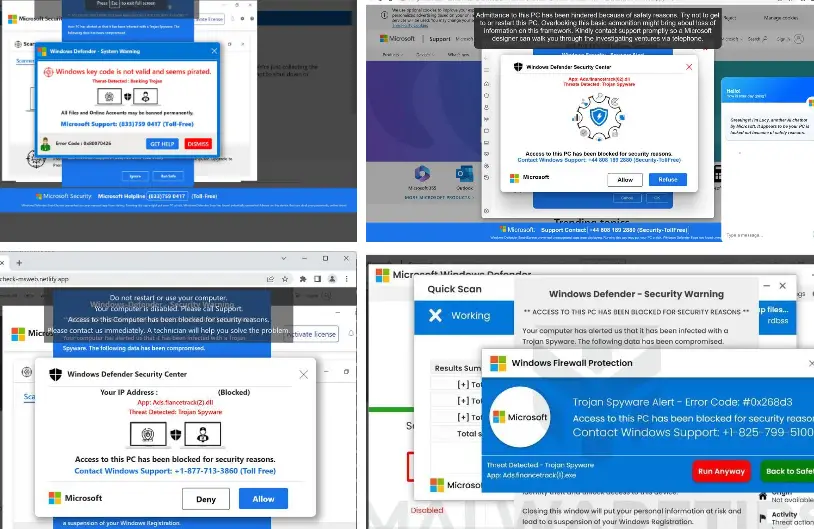The Microsoft Security Alert Scam is a scam text sent by scammers claiming to be the Microsoft Support. It actually started in 2021 but it has resurfaced again this year, 2024. These scammers are on the prowl and anyone that falls victim ends up losing money, personal data that could result in Identity theft.
What The Microsoft Security Alert Scam Looks Like

The Microsoft Security Alert Scam usually pops on as a notification on your computer. While sometimes a number calls you claiming to be the Microsoft Security team.
These scams often aim to trick users into believing their computer is infected with a virus or has been compromised, prompting them to call a fake support number or click on malicious links. However, entering your details on this page will not change any of your account information. Instead, you will be sending your details to a malicious actor who can use them to log into your account and steal more data.
How To Identify Phishing Scams Like Microsoft Security Alert Scam
Now here is how to identify Phishing attempts like the Microsoft Security Alert Scam:
- Unsolicited Pop-ups: Real security alerts from Microsoft or other legitimate companies will not randomly appear in your web browser.
- The message always creates a sense of urgency and pressure, claiming that you must act immediately to claim your prize, are often scams designed to prevent you from thinking too much or seeking advice.
- They always request for personal or financial information.
- It always comes with a suspicious link, Links leading to unfamiliar websites or ones that don’t look quite right (e.g., misspelled URLs, unsecure HTTP sites)
Avoiding phishing scams requires vigilance and awareness. Here are some effective strategies to protect yourself from phishing attacks:
Tips to Avoid Phishing Scams:
- Be Skeptical of Unexpected Communications:
- Be cautious with unsolicited emails, texts, or calls, especially those asking for personal or financial information.
- Verify the Source:
- Always verify the sender’s email address or phone number. Scammers often use addresses or numbers that look similar to legitimate ones.
- Look for Red Flags:
- Check for spelling and grammatical errors, generic greetings (e.g., “Dear Customer”), and urgent or threatening language.
- Don’t Click on Suspicious Links:
- Hover over links to see the actual URL before clicking. If it looks suspicious or doesn’t match the purported sender, don’t click it.
- Check the Website’s Security:
- When entering personal information online, ensure the website is secure. Look for “https://” in the URL and a padlock icon in the browser’s address bar.
- Avoid Downloading Attachments:
- Don’t open email attachments from unknown or suspicious sources. These could contain malware.
- Use Multi-Factor Authentication (MFA):
- Enable factor Authentication on your accounts so as to add an extra layer of security. This makes it harder for scammers to gain access even if they have your password.
- Report Phishing Attempts:
- Report suspicious emails to your email provider and the organization being impersonated. In the U.S., you can forward phishing emails to the Anti-Phishing Working Group at [email protected] and to the FTC at [email protected].
What Do You Do When You Suspect A Phishing Attempt
In this digital age and time, almost everyone has at one time received a phishing text or email and often times they fall victim and get scammed. This is why it is imperative that you are always careful when you receive any text or email because one careless click on a link can cause a whole lot of problems for you. Now if you suspect a phishing attempt, here are what I advise you do:
- Do Not Respond to the text, because you responding is actually giving access to the scammers, simply delete it when you receive.
- Quickly change your password if you have mistakenly clicked on the link or given away your login details. Change your password to a strong and unique password.
- Keep an eye on your accounts for any unauthorized transactions.
- Also scan you devices for any malware.
By following these tips, you can significantly reduce your risk of falling victim to phishing scams and keep your personal and financial information safe.
Conclusion
This internet age came with so many advantages and also disadvantages. Phishing is an example of one of such. Internet users should always apply caution and be wary. Scammers often use scare tactics or urgency to manipulate individuals into taking quick actions. It’s essential to stay vigilant and take precautions to protect your personal information and finances from such scams.